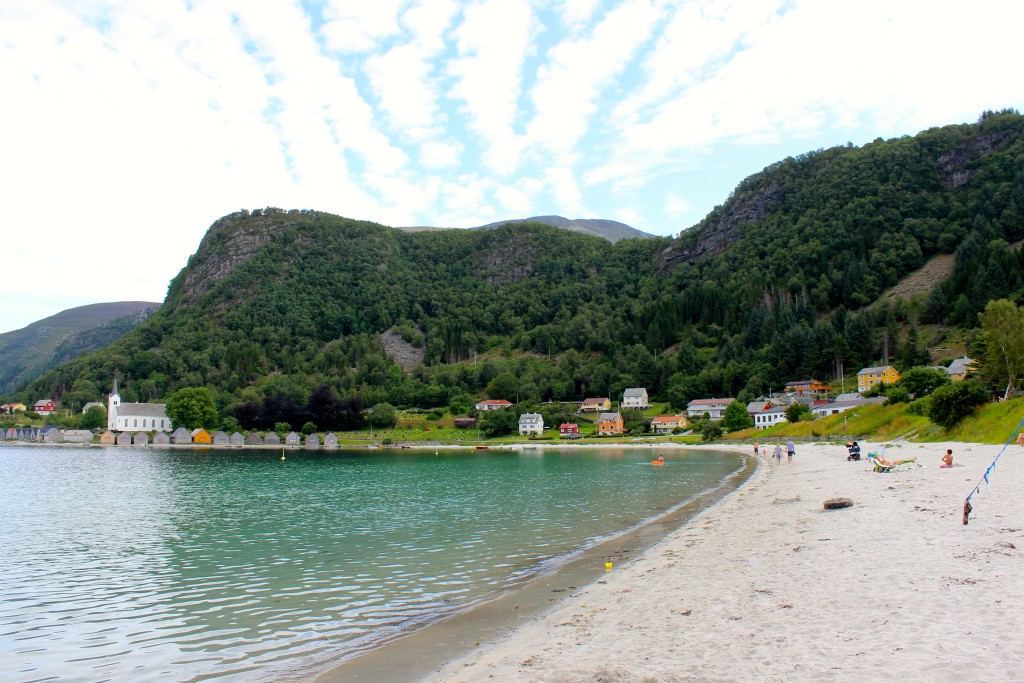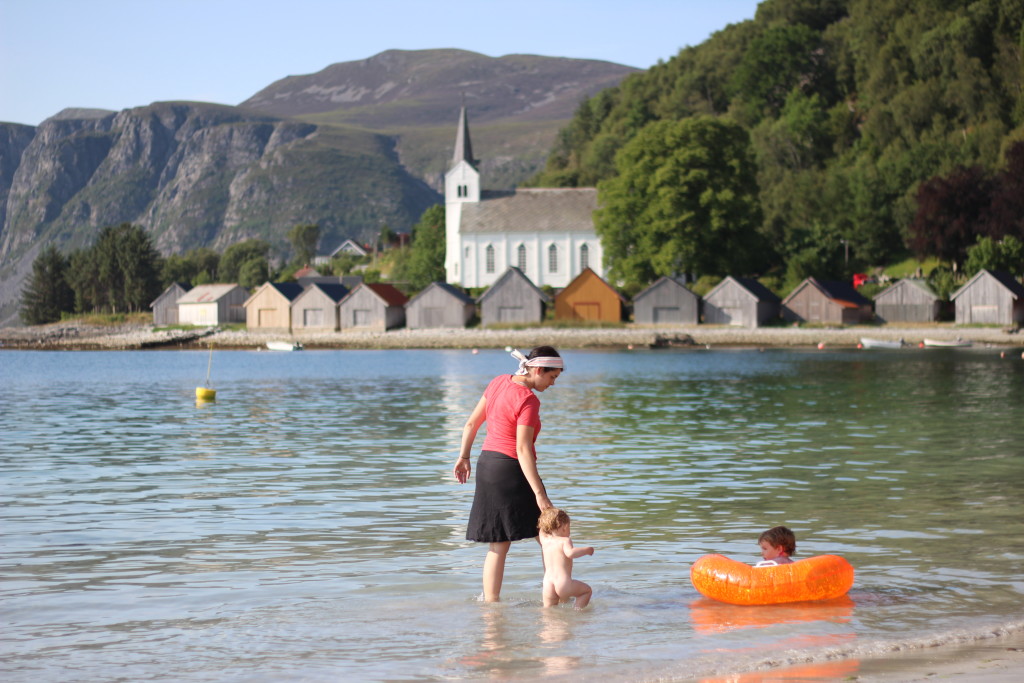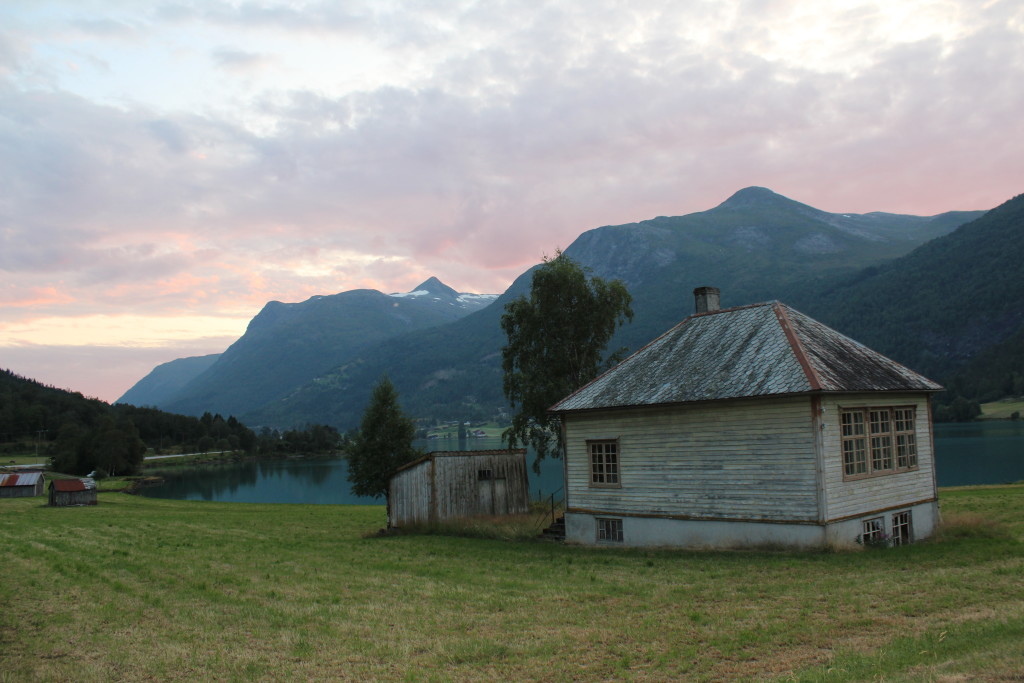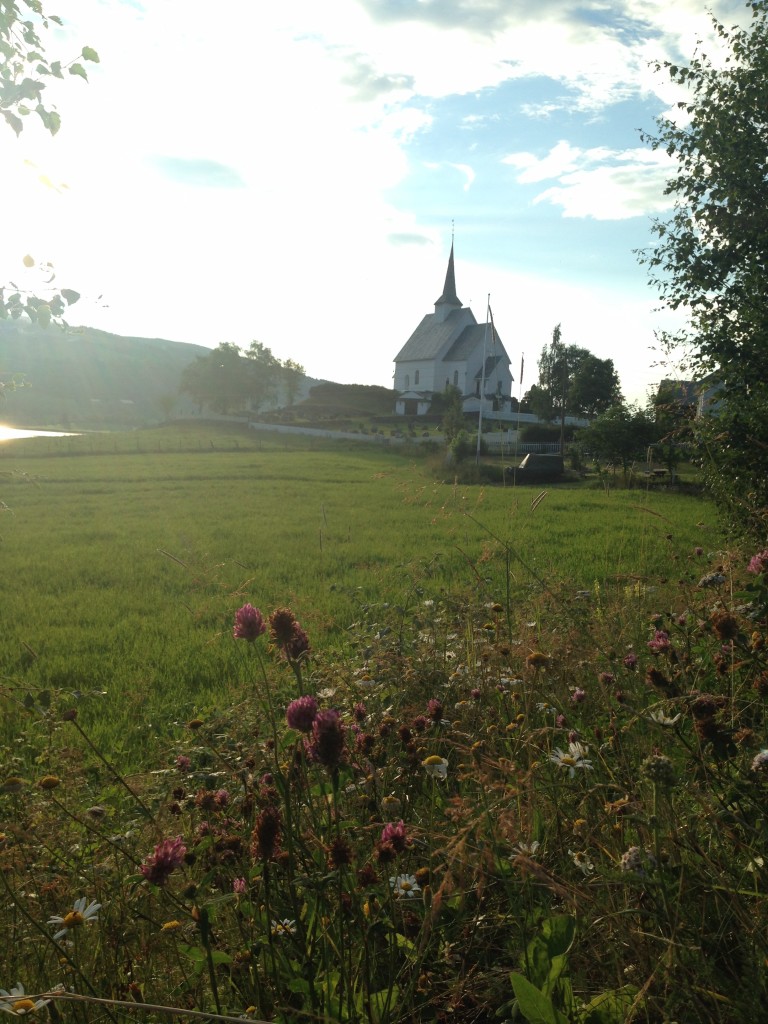Carl Hoiland is a Ph.D. Candidate at Stanford University studying tectonics of the Cordillera. This post (in two parts) comes from a trip he took while as an NSF GRFP GROW visiting researcher at Stockholm University. This is part I: a pilgrimage.
Part II: the rocks (and peripherals) can be seen here.
Had it been in any less remarkable part of the world, the small coastal village of Selje in western Norway might have become a household name. Like Mykonos or the Amalfi coast it could have been on anyone’s dream list of “must see” destinations. In mid-summer it would be overrun by vacationers on holiday enthralled by its quaint Norwegian charm, by the land where warm Atlantic waters meet the turquoise outwash of glacial fjords. And, yet, on a sun-filled day in late July this summer past, it was immediately apparent to me that I was the only foreigner there.
Marked by ancient chapels and monasteries, white sand beaches, and wooden cottages, Selje, with its backdrop of hanging valleys and ice-sculpted vistas, nestles into the part of my memory where usually dreams reside. While crowds flocked to Flåm or Bergen (both well-deserving of their acclaim, but which I hurriedly drove past in my rush to arrive here), I found myself alone walking a long stretch of beach, until the sand gave way to pebbles… gave way to cobbles… gave way to solid rock. Past the Church of Selje, beyond the last in a row of boathouses, I followed a field journal of a geologist decades before me to see for myself the outcrop that spelled upheaval to the science of plate tectonics.
It was a two-day drive in our rented Volvo from the Stockholm archipelago to the fjordland district of Selje, Ashley and I taking turns at the wheel. Our two toddlers in the backseat punctuated their motion sickness by the occasional joyful cheer at a passing waterfall as the road swerved up and around mountain passes. This isn’t the first, nor will it be the last time they’ve permitted me to drag them to the ends of the land, ignoring the obvious sites, to see some hallowed ground of geologic importance. We packed a trunk full of food and of camping gear to keep us free of the sparse and costly accommodations in the region. We rose from the low lake-pocked cratonic plains of Sweden through the foothills of the Scandinavian Caledonides until we reached the Atlantic shoreline. At last, my 1,300-kilometer pilgrimage came to an end.
Now, I should say that I had lived near the only comparably important locality of its type ten years prior, but I was oblivious at that time to its significance. So, with my family playing in the sand behind me, I walked on alone to a relatively un-extraordinary-looking green rock that had helped redefine our modern view of plate tectonics: the Grytting eclogite in Selje, Norway.
It was here in Selje, three decades ago, that David Smith (1984) first recognized coesite (the high-pressure polymorph of quartz, SiO2) preserved as mineral inclusions within eclogitic pyroxenes, thereby establishing the ultra-high pressure (UHP) conditions of their metamorphism. Not coincidentally, it was here on this same beach, six decades before Smith, that Pentii Eskola (1921) had described his “eclogite-pegmatite of the Gryting type” while characterizing high-pressure facies assemblages regionally:
“At Grvtingvaag near the church of Selje I met with a lens of extremely coarse-grained eclogite pegmatite…” (Eskola, 1921)
Despite how common its chemical constituents are in nature, coesite is very rare. So rare, in fact, that coesite had never been considered until the early 1950’s when it was first synthesized during a high-pressure laboratory experiment (Coes, 1953, published in Science). Loring Coes, Jr., a chemist at Norton Company, recognized the importance of his discovery to geological science: “Its absence from [deep-seated] rocks provides a maximum pressure above which they could not have formed.” That limit, refined by later workers as roughly 2.5 gigapascals, corresponds to a depth of about 80 kilometers. However, “the possibility exists,” he continued, “that the existence of this form of silica in nature may have been overlooked.” (Coes, 1953) It would require seven years of concerted effort by the geological community before this latter statement could be shown correct.
In 1960, Chao, Shoemaker, and Madsen published a Science article announcing their discovery of natural coesite formed as a result of a meteorite impact in the Coconino sandstone at Meteor Crater, Arizona. Such a natural specimen meant that coesite could now be considered a true mineral, and its association with shock from bolide impact meant that it would prove useful for identifying impact craters elsewhere. However, for the time being, it seemed that coesite was relegated to the realm of freak incidents of the extraterrestrial variety. Another seventeen years pass and coesite is discovered in kimberlites (Sobolev et al 1976; Smyth and Hatton, 1977), which are volcanic rocks thought to erupt rapidly from a deep source within the mantle (e.g. diamond-bearing), but the crustal story remains the same. And so for the thirty years subsequent to its synthesis in a Norton laboratory, it seemed that coesite’s absence from metamorphic rocks really did mean that no crustal rocks had ever been carried to or from such depths. The crust was too buoyant, we believed, to be subducted into the mantle; or if ever it was, it could never return; it was consumed. But that paradigm would have to change in 1984.
Smith’s coesite discovery in the grytting eclogite at Selje in western Norway (published in Nature, 1984) came only months after Christian Chopin announced a similar find (guided by the work of Pierre Vialon) in the western Alps (Contr. Min. Pet, 1984), which together represent the first recognition of tectonic coesite in crustal rocks. These two observations proved definitively that subduction could in fact carry crustal rocks to mantle depths and then could somehow draw them back to the surface in equally impressive fashion.
“The range of pressure endured by crustal rocks of continental derivation might be in fact much wider than presently thought. Some of our present concepts about earth tectonics might have to be modified by these coesite discoveries and other possible ones to come.” (Chopin, 1984)
Today, thanks to a wide community effort, coesite and even micro-diamond (formed at various times in earth’s past whenever rocks have been driven to mantle depths and back) have been identified in more and more places around the globe as witnesses to the incessant upheaval of the Earth’s crust and mantle: plate tectonics. Our models have been significantly improved by the revision.
“Eventually, the role of continental crust in geodynamics may have to be reconsidered.” (Chopin, 1984)
“Current geodynamic models of lithospheric plate interaction need revising to take account of extraordinary vertical components of movements.” (Smith, 1984)
As I mentioned, I had once stood in a place similar to Selje but without any of my current appreciation for what importance it held. It was ten years ago and I was living in a suburb of Torino at the foot of the Italian Alps. I was a young Mormon missionary at the time and occasionally had assignments that would take me high into the mountains to assist three elderly women of our congregation prepare wood piles for winter before the snow barricaded their long driveway. They lived in the Dora Maira massif, the very same where Christian Chopin had made his discovery of crustal coesite just prior to that of Smith’s, but neither those women nor I had ever heard such a name nor imagined such a story. I had once come within fifteen miles of Chopin’s type locality, but my pilgrimage then was altogether different. So, although I had other reasons to remove my sandals, I failed to see that burning bush–
to mantle depths, nec tamen consumebatur.
We’re learning to decipher the Earth’s language. We’re learning to read its story. At times it is a slow march towards understanding. At other times it explodes with extraordinary clarity. Our ideas can be turned on their heads as new observations force our intellectual hand. But, it’s the continual search and the freedom to explore that keeps it perpetually meaningful to me.
Further reading:
Eskola (1921), eclogites of Norway, P. Skr. Norske Vidensk·Akad. Selsk. Christiania Mat.·Nat.urv. K18, 1-118. https://archive.org/details/oneclogitesofnor00eskoiala
Coes, L., Jr. (31 July 1953). “A New Dense Crystalline Silica”. Science 118 (3057): 131–132.
Chao, E. C. T.; Shoemaker, E. M.; Madsen, B. M. (1960). “First Natural Occurrence of Coesite”. Science 132 (3421): 220–2.
Sobolev NV et al. (1976) Coesite, garnet and omphacite inclusions in Yakut diamonds – first finding of coesite paragenesis. Dokl Akad Nauk SSSR 230:1442-1444 (in Russian) Abstr in Mineral Abstr 78-818
Smyth JR, Hatton CJ (1977) A coesite-sanidine grospydite from the Roberts Victor kimberlite. Earth Planet Sci Lett 34:284-290
Chopin C (1984) Coesite and pure pyrope in high-grade blueschists of the Western Alps: a first record and some consequences. Contributions to Mineralogy and Petrology 86: 107-118
Smith DC (1984) Coesite in clinopyroxene in the Caledonides and its implications for geodynamics. Nature 310: 641-644
![]() This work is licensed under a Creative Commons Attribution-NonCommercial-ShareAlike 4.0 International License.
This work is licensed under a Creative Commons Attribution-NonCommercial-ShareAlike 4.0 International License.








